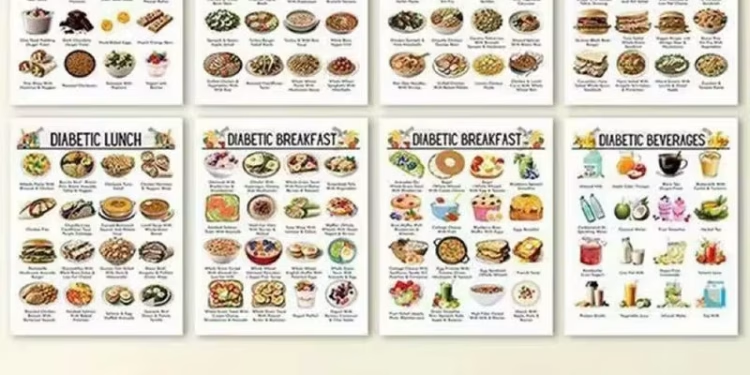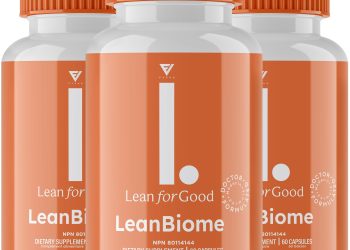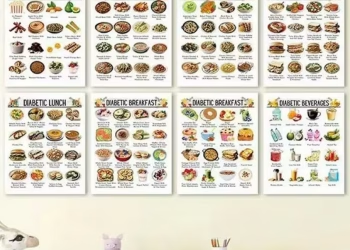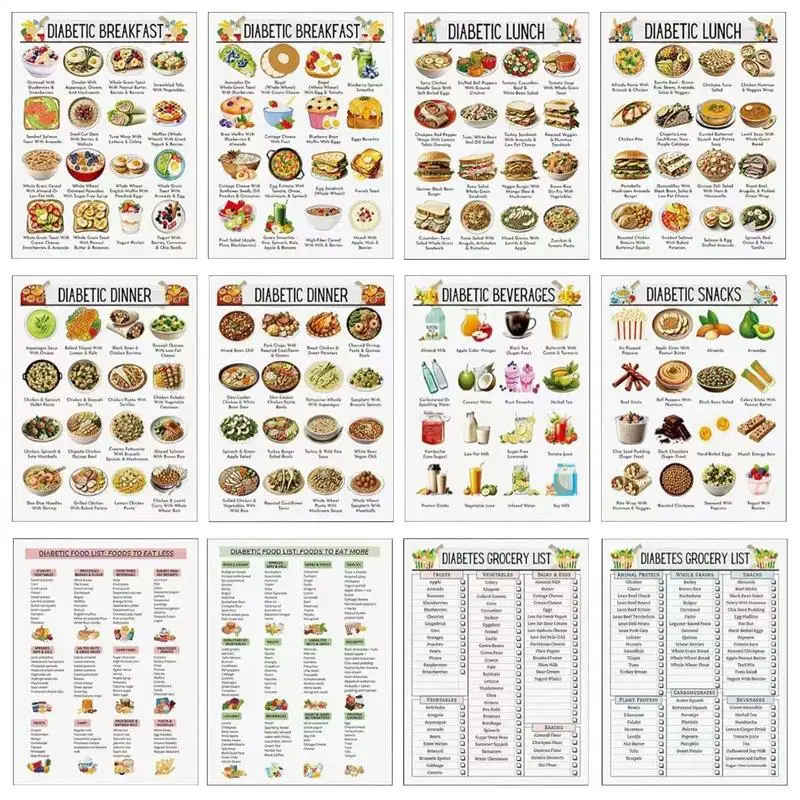

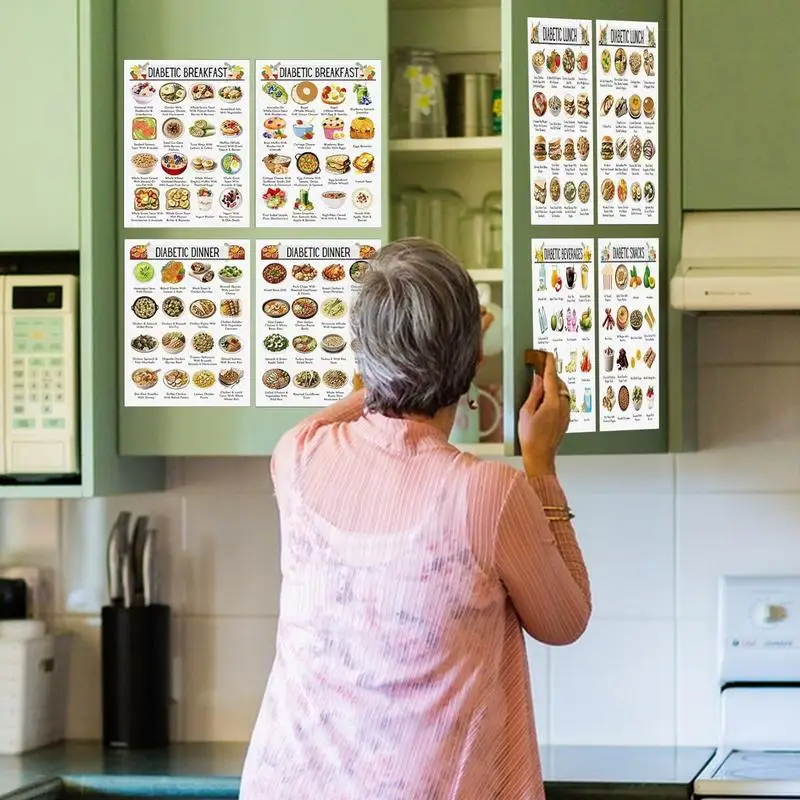

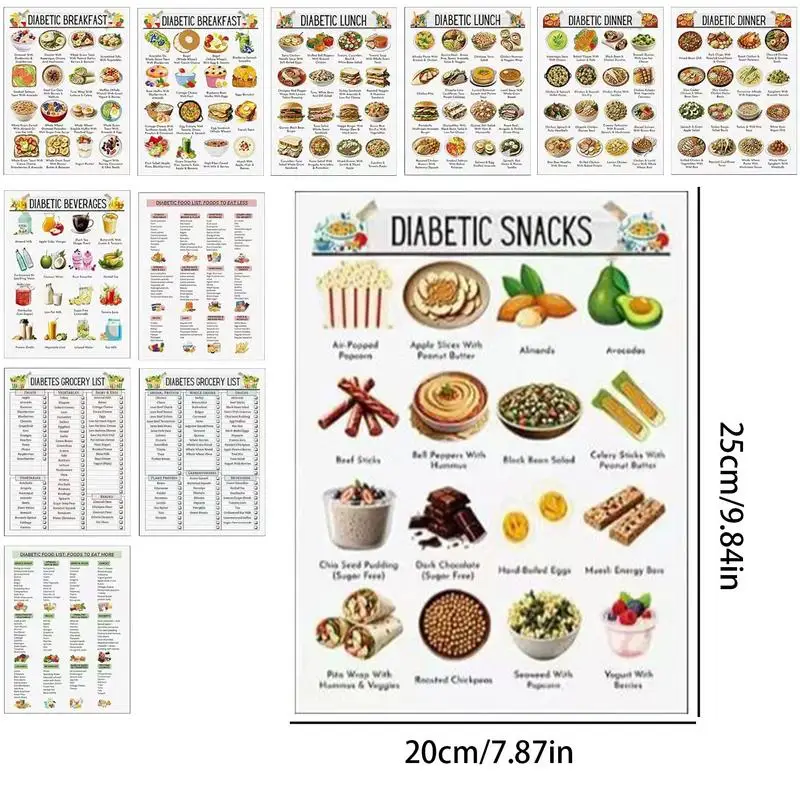
Price: $10.79 - $5.29
Understanding Low-Sugar, Low-Carb Diets: A Guide for Seniors and Their Families
Navigating dietary changes can be challenging, especially for older adults. This comprehensive guide explores the benefits of a low-sugar, low-carb diet, focusing on practical food choices and strategies for incorporating them into everyday life. We’ll specifically examine the usefulness of a “12pcs Low Sugar Food Chart Low Carb Diet Nutrition List Food Information Guide Poster” designed for easier comprehension and implementation.
What is a Low-Sugar, Low-Carb Diet?
A low-sugar, low-carb diet emphasizes reducing the intake of sugars and carbohydrates, primarily found in processed foods, sugary drinks, grains, and some fruits. The goal is to shift the body’s primary energy source from glucose (from carbohydrates) to fat, a process known as ketosis.
This dietary approach offers potential benefits such as weight management, improved blood sugar control, and reduced risk of certain chronic diseases, making it a valuable consideration for seniors.
Why is it Beneficial for Seniors?
As we age, our bodies undergo various physiological changes, impacting our metabolic rate and increasing the risk of health conditions. A low-sugar, low-carb diet can be particularly beneficial for seniors in several ways:
- Improved Blood Sugar Control: Helps manage or prevent type 2 diabetes by stabilizing blood glucose levels.
- Weight Management: Supports healthy weight loss or maintenance, reducing strain on joints and improving mobility.
- Reduced Inflammation: Lower carbohydrate intake can decrease inflammation throughout the body, potentially alleviating symptoms of arthritis and other inflammatory conditions.
- Enhanced Cognitive Function: Some studies suggest a low-carb diet may improve cognitive function and protect against age-related cognitive decline.
- Cardiovascular Health: Can improve cholesterol levels and reduce blood pressure, contributing to better heart health.
The Role of a “12pcs Low Sugar Food Chart Low Carb Diet Nutrition List Food Information Guide Poster”
The “12pcs Low Sugar Food Chart Low Carb Diet Nutrition List Food Information Guide Poster” serves as a visual aid, simplifying the process of food selection and meal planning. It typically includes:
- Categorized Food Lists: Divides foods into groups based on their carbohydrate content (e.g., vegetables, proteins, fats).
- Visual Representations: Uses images and colors to make information more accessible, especially for those with visual impairments or cognitive limitations.
- Portion Size Guidelines: Provides recommendations for appropriate serving sizes to help control carbohydrate intake.
- Sugar and Carb Counts: Lists the approximate sugar and carbohydrate content of various foods, enabling informed choices.
Understanding Food Categories: Your Low-Sugar, Low-Carb Grocery List
Here’s a breakdown of food categories suitable for a low-sugar, low-carb diet, often highlighted in a food chart poster:
- Non-Starchy Vegetables: These are the cornerstone of a low-carb diet. Think leafy greens (spinach, kale, lettuce), broccoli, cauliflower, asparagus, bell peppers, cucumbers, and zucchini. They are low in carbs and high in fiber and nutrients.
- Healthy Fats: Incorporate sources of healthy fats such as avocados, olive oil, coconut oil, nuts (almonds, walnuts, macadamia nuts), seeds (chia seeds, flax seeds, sunflower seeds), and fatty fish (salmon, tuna, mackerel).
- Protein Sources: Opt for lean protein sources like chicken, turkey, fish, eggs, beef (in moderation), and tofu.
- Dairy (in Moderation): Full-fat dairy products like cheese, heavy cream, and plain Greek yogurt can be included in moderation, as they contain some carbohydrates. Be mindful of added sugars in flavored yogurts.
- Low-Carb Fruits (in Moderation): Berries like strawberries, blueberries, raspberries, and blackberries are lower in carbohydrates than other fruits and can be enjoyed in small portions.
- Nuts and Seeds: Almonds, walnuts, chia seeds, and flax seeds are excellent sources of healthy fats and fiber.
Foods to Limit or Avoid: Navigating the High-Sugar, High-Carb Landscape
Understanding what to avoid is just as crucial as knowing what to eat. Common culprits include:
- Sugary Drinks: Soda, juice, sweetened tea, and sports drinks are loaded with sugar and should be avoided entirely.
- Processed Foods: These often contain hidden sugars and unhealthy fats. Read labels carefully and opt for whole, unprocessed foods whenever possible.
- Grains: White bread, pasta, rice, and cereals are high in carbohydrates. Choose low-carb alternatives like cauliflower rice or zucchini noodles.
- Starchy Vegetables: Potatoes, corn, and peas are higher in carbohydrates than non-starchy vegetables and should be consumed in moderation.
- Sugary Snacks and Desserts: Candy, cookies, cakes, and ice cream are high in sugar and should be avoided.
- High-Sugar Fruits: Bananas, grapes, mangoes, and pineapples are higher in sugar than berries and should be limited.
Sample Meal Plan for a Low-Sugar, Low-Carb Diet (Suitable for Seniors)
This is a sample meal plan; adjust portion sizes and food choices based on individual needs and preferences. Always consult with a healthcare professional or registered dietitian for personalized guidance.
- Breakfast: Scrambled eggs with spinach and cheese, or full-fat Greek yogurt with berries and a sprinkle of almonds.
- Lunch: Salad with grilled chicken or salmon, avocado, and a low-carb dressing, or a hearty vegetable soup with a side of cheese.
- Dinner: Baked salmon with roasted broccoli and cauliflower, or a ground beef and vegetable stir-fry with cauliflower rice.
- Snacks: A handful of almonds, a piece of cheese, or a small serving of berries.
Tips for Successfully Implementing a Low-Sugar, Low-Carb Diet for Seniors
Making dietary changes can be challenging, but these tips can help seniors successfully adopt a low-sugar, low-carb diet:
- Start Slowly: Gradually reduce sugar and carbohydrate intake to allow the body to adjust.
- Plan Meals in Advance: Planning meals ahead of time can help avoid impulsive, unhealthy food choices.
- Read Food Labels Carefully: Pay attention to sugar and carbohydrate content, serving sizes, and added ingredients.
- Stay Hydrated: Drink plenty of water throughout the day to help flush out toxins and prevent dehydration.
- Get Support: Enlist the help of family members, friends, or a registered dietitian to stay motivated and on track.
- Listen to Your Body: Pay attention to how your body responds to the diet and adjust accordingly.
- Prioritize Nutrient Density: Choose foods that are rich in vitamins, minerals, and antioxidants.
- Be Patient: It takes time for the body to adapt to a new way of eating. Don’t get discouraged if you don’t see results immediately.
Potential Challenges and Solutions
While a low-sugar, low-carb diet offers many benefits, some challenges may arise:
- Constipation: Increase fiber intake by consuming plenty of non-starchy vegetables and adding flax seeds or chia seeds to meals.
- “Keto Flu”: Some people experience flu-like symptoms (headache, fatigue, nausea) when first starting a low-carb diet. Stay hydrated and increase electrolyte intake (sodium, potassium, magnesium) to alleviate symptoms.
- Social Situations: Eating out or attending social events can be challenging. Plan ahead by researching menus or bringing your own low-carb snacks.
- Medication Interactions: Certain medications may need to be adjusted when following a low-carb diet. Consult with a doctor or pharmacist to ensure safety.
Using the “12pcs Low Sugar Food Chart Low Carb Diet Nutrition List Food Information Guide Poster” Effectively
Here’s how to maximize the benefits of the food chart poster:
- Hang it in a visible location: Place the poster in the kitchen or dining area for easy reference.
- Use it for meal planning: Refer to the poster when creating meal plans and grocery lists.
- Educate family members: Share the poster with family members who are involved in meal preparation.
- Highlight favorite foods: Mark preferred low-carb options for quick identification.
- Update it regularly: Replace outdated information with current recommendations.
FAQs About Low-Sugar, Low-Carb Diets for Seniors
Is a low-carb diet safe for elderly individuals?
Generally, yes, but it’s crucial to consult with a healthcare professional or registered dietitian before making significant dietary changes, especially if the individual has underlying health conditions or is taking medications. They can assess individual needs and ensure the diet is safe and appropriate.
Will a low-carb diet help with weight loss in older adults?
A low-carb diet can be effective for weight loss, but it’s not a magic bullet. It works by reducing carbohydrate intake, which can lead to lower insulin levels and increased fat burning. However, a healthy and sustainable approach to weight loss also involves regular exercise and a balanced diet overall.
What are some common side effects of starting a low-carb diet?
Some people may experience temporary side effects like the “keto flu” (headache, fatigue, nausea), constipation, or bad breath. These side effects usually subside within a few days or weeks as the body adapts to the new diet.
How much protein should elderly individuals consume on a low-carb diet?
Protein needs vary based on age, activity level, and overall health. Generally, elderly individuals should aim for 0.8 to 1.2 grams of protein per kilogram of body weight per day. A registered dietitian can provide personalized recommendations.
Can a low-carb diet improve blood sugar control in seniors with diabetes?
Yes, a low-carb diet can be very effective for improving blood sugar control in seniors with type 2 diabetes. By reducing carbohydrate intake, the diet helps to lower blood glucose levels and reduce the need for medication.
Are there any specific nutrients that seniors should pay attention to on a low-carb diet?
Seniors on a low-carb diet should pay attention to their intake of fiber, electrolytes (sodium, potassium, magnesium), and calcium. Adequate fiber intake can help prevent constipation, while electrolytes are important for maintaining fluid balance. Calcium is essential for bone health.
How can I make a low-carb diet more appealing to elderly individuals with reduced appetites?
Focus on flavorful and nutrient-dense foods that are easy to chew and swallow. Offer smaller, more frequent meals throughout the day. Prepare meals with a variety of colors and textures to make them more visually appealing. Consider adding healthy fats like avocado or olive oil to enhance flavor and calorie density.
Where can I find low-carb recipes that are suitable for seniors?
Numerous websites, cookbooks, and online communities offer low-carb recipes that are specifically designed for seniors. Search for recipes that are easy to prepare, use simple ingredients, and are tailored to meet the nutritional needs of older adults.
Review of a Typical “12pcs Low Sugar Food Chart Low Carb Diet Nutrition List Food Information Guide Poster”
Pros:
- Visual Clarity: The use of pictures and colors makes the information easier to understand, especially for those with cognitive limitations.
- Convenience: Provides a quick reference guide for food choices, eliminating the need to constantly search for information online.
- Motivation: Can serve as a visual reminder of dietary goals, promoting adherence to the diet.
- Organization: Categorizes foods logically, making it easier to plan meals.
- Accessibility: Can be easily displayed in the kitchen or dining area for quick access.
Cons:
- Generic Information: The information may not be tailored to individual needs or health conditions.
- Limited Detail: The poster may not provide detailed information about portion sizes or nutrient content.
- Potential for Misinterpretation: Some information may be misinterpreted if not explained clearly.
- Dependence on Visuals: May not be suitable for individuals with severe visual impairments.
- Cost: While relatively inexpensive, there is still a cost associated with purchasing the poster.
Conclusion: Empowering Seniors with Informed Dietary Choices
A low-sugar, low-carb diet can offer significant health benefits for seniors, from improved blood sugar control and weight management to reduced inflammation and enhanced cognitive function. While dietary changes should always be made in consultation with a healthcare professional, tools like the “12pcs Low Sugar Food Chart Low Carb Diet Nutrition List Food Information Guide Poster” can play a valuable role in simplifying the process and promoting adherence to a healthy eating plan. By providing clear, visual information about food choices, these posters empower seniors and their families to make informed decisions that support their overall well-being.

